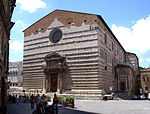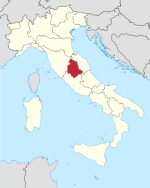Perugia (, US also , Italian: [peˈruːdʒa] (listen); Latin: Perusia) is the capital city of Umbria in central Italy, crossed by the River Tiber, and of the province of Perugia.
The city is located about 164 km (102 mi) north of Rome and 148 km (92 mi) southeast of Florence. It covers a high hilltop and part of the valleys around the area. The region of Umbria is bordered by Tuscany, Lazio, and Marche.
The history of Perugia goes back to the Etruscan period; Perugia was one of the main Etruscan cities.
The city is also known as the universities town, with the University of Perugia founded in 1308, the University for Foreigners, and some smaller colleges such as the Academy of Fine Arts "Pietro Vannucci" (Italian: Accademia di Belle Arti "Pietro Vannucci") public athenaeum founded in 1573, the Perugia University Institute of Linguistic Mediation for translators and interpreters, the Music Conservatory of Perugia, founded in 1788, and other institutes.
Perugia is also a well-known cultural and artistic centre of Italy. The city hosts multiple annual festivals and events, e.g., the Eurochocolate Festival (October), the Umbria Jazz Festival (July), and the International Journalism Festival (in April), and is associated with multiple notable people in the arts.
Painter Pietro Vannucci, nicknamed Perugino, was a native of Città della Pieve, near Perugia. He decorated the local Sala del Cambio with a series of frescoes; eight of his pictures can also be seen in the National Gallery of Umbria.Perugino was the teacher of Raphael, the great Renaissance artist who produced five paintings in Perugia (today no longer in the city) and one fresco. Another painter, Pinturicchio, lived in Perugia. Galeazzo Alessi is the most famous architect from Perugia.The city's symbol is the griffin, which can be seen in the form of plaques and statues on buildings around the city. It is also the symbol of the local football club A.C. Perugia, who have previously played in the Serie A.









